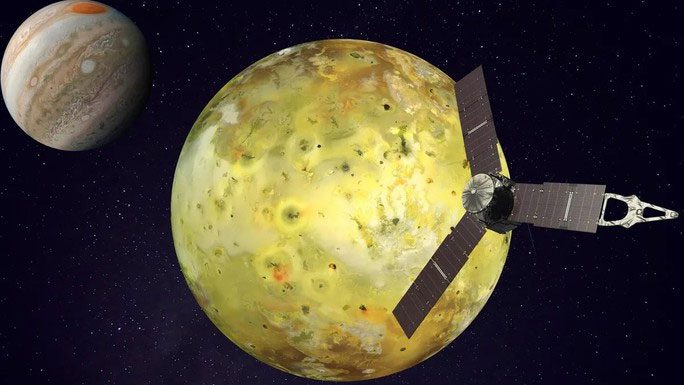Two leading “warrior” observatories of NASA will collaborate with the Juno spacecraft during its next flyby to explore the mysteries of Io – a moon with “golden” conditions for life.
The two most powerful space telescopes in the world, James Webb and Hubble, operated by NASA, will focus directly on Jupiter’s moon Io in the upcoming mission, working alongside the Juno spacecraft to decode one of the most mysterious regions ever studied by the agency, according to Space.
Io and Earth are the only two celestial bodies in the Solar System and in the known universe that have been identified as having geological activity.

Io with the Juno spacecraft in the foreground and Jupiter in the background – (Photo: NASA)
On our planet, geological activity is one of the “keys to life,” playing a crucial role in stabilizing the atmosphere and magnetosphere, maintaining chemical composition, and generating the necessary stimuli for life to emerge in ancient times…
Initially, NASA believed that Io could not support life due to its intense geological activity. Io is often referred to as the “volcanic moon”, with hundreds of volcanoes, both large and small, continuously active. However, subsequent evidence has left the question of whether Io can support life open for debate.
The new “attack” direction from James Webb and Hubble will be authorized by the Southwest Research Institute (SwRI) in the U.S., which has been permitted by the Space Telescope Science Institute – the operator of NASA’s observatories – to observe using James Webb and Hubble.
The SwRI team will collect data on Io during 122 orbits of the telescope, supplemented by 5 hours of observation using James Webb.
Next year, the Juno spacecraft will also fly past this volcanic moon multiple times, providing opportunities for simultaneous multi-directional “attacks,” allowing for precise data comparisons.
The principal investigator of the new mission, Dr. Kurt Retheford, stated that they hope to bring back new insights into Io’s powerful volcanic activity, the interaction between the moon and neutral gas, as well as the plasma neutral gas population flowing through Jupiter’s magnetic field – which triggers this planet’s intense auroral emissions.
Io is roughly the size of Earth’s Moon and is one of Jupiter’s Galilean moons. The Galilean moons are a group of the four largest moons of this planet, which includes Io, Europa, Ganymede, and Callisto.
NASA and other space research agencies remain optimistic about the potential for life on Europa, have high hopes for Ganymede and Callisto, but are skeptical about Io.




















































